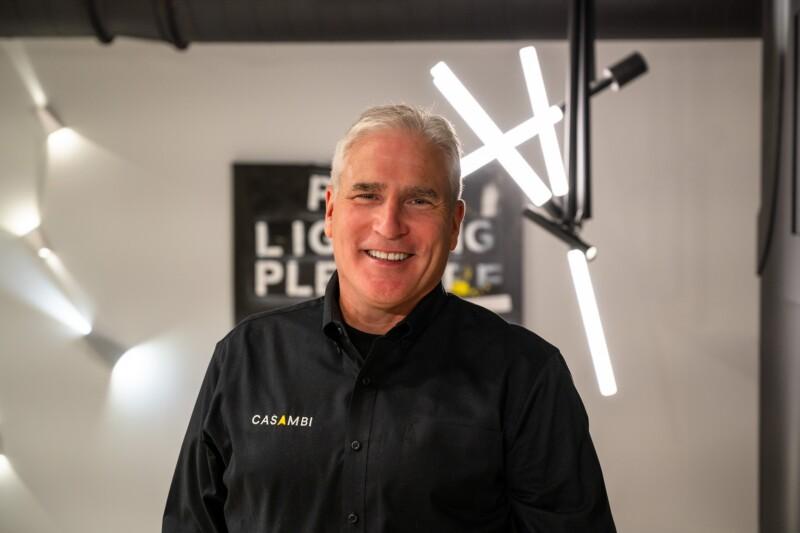A brief history of smart lighting control

Digital technology has transformed the way we live – and wireless lighting control is no exception. In today’s age of smartphones, wireless communication and high-speed connectivity, the way we control lights is undergoing a revolution. Here we plot the key milestones in the development of smart lighting controls, from the first light switch to the age of the internet of things.
1884 – The modern light switch is invented 1
1959 – The dimmer switch is invented 2
1989 – The short-link radio technology that later becomes Bluetooth is invented 3
1992 – Shuji Nakamura invents the blue LED, kickstarting the digital lighting revolution 4
1998 – DALI – the most widely used digital lighting control protocol – is codified 5
1999 – The term “internet of things” is coined, by a Procter & Gamble executive discussing the use of RFID in the supply chain 6
2006 – Nokia launches the revolutionary Wibree communication technology, which later becomes Bluetooth Low Energy 7
2007 – Apple launches the first iPhone, beginning the smartphone revolution 8
2010 – Next comes the iPad, which sees tablets go mainstream 9
2011 – Casambi is founded, with the aim of using Bluetooth Low Energy to change how we interact with objects around us
2011-12 – The first mobile devices featuring Bluetooth Low Energy come on the market 10
2015 – The number of people in Western Europe with a smartphone passes 50% 11
2016 – The number of connected devices in the world exceeds five billion (not counting phones and tablets 12
Traditional lighting controls
Lighting controls have come a long way in the past couple of decades. Yet most of today’s systems are still based on old standards. The DALI standard was conceived more than 20 years ago in a world when computing power was limited, the internet as we know it barely existed, and smartphones were still a decade away. DALI has served us well, but to fully realise the potential of today’s technology, a new approach is needed.
Bluetooth Low Energy
Bluetooth Low Energy (which began life in 2006 as Wibree) was originally developed by Nokia and later integrated with the existing Bluetooth standard. Today, Bluetooth Low Energy is built in to every smartphone, tablet ,laptop and smart watch, making it the obvious choice for applications such as Casambi. In fact, Casambi’s founders, who used to work at Nokia, saw the potential of Bluetooth Low Energy from the start, and have been working with it since before there were even any compatible devices on the market.
Casambi
Casambi was founded in 2011 by Timo Pakkala and Elena Lehtimäki, formerly of Nokia Research Center. Timo and Elena believed that smartphones and wireless technology could transform how we interact with the objects around us. In particular, they believed that Bluetooth Low Energy – a new technology that began life at Nokia – was the key to making connected devices truly smart. Now the Casambi app is helping to put truly “smart” control in the hands of lighting users.
Sources
- Clayson, John, What’s in store, Tyne and Wear Archives & Museums (2013) ;
Who is Crabtree Electrical?, SND Electrial - Spira, Joel, Patent US3032688 – Dimming device (1962) ;
Joel Spira, who patented light-dimmer switch, dies at 88, Associated Press (2015) - Tonner, Dominic, The Bluetooth Blues, Information Age (2001) https://web.archive.org/web/20071222231740/http://www.information-age.com/article/2001/may/the_bluetooth_blues;
Ullman, Johan, Patent SE9202239 (1992) - Blue LEDs – Filling the World with Light, Royal Swedish Academy of Sciences (2014);
Nobel Prize in Physics for Blue LEDs (2014), American Physical Society - DALI basics- A refresher course, Archlighting.com, (2007);
DALI lighting control solutions explained, Creston (2012) - Ashton, Kevin, That “internet of things” thing, RFID Journal (2009);
Gabbai, Arik, Kevin Ashton describes the internet of things, Smithsonian Magazine (2015) - Grabionowski, Ed, Is Wibree going to rival Bluetooth?, How Stuff Works
- Cohen, Peter, Macworld Expo Keynote Live Update, Macworld (2007);
Farber, Dan, Jobs – Today Apple is going to reinvent the phone, ZDNet (2007) - iPad available in nine more countries on May 28, Apple (2010);
iPad fans mob Apple stores, BBC (2010) - Apple launches iPhone 4S, Apple (2011);
Bluetooth 4.0 – What is it, and does it matter?, CNET (2011) - Smartphone user penetration as percentage of total population in Western Europe from 2011 to 2018, Statista;
Mobile phone, smartphone usage varies globally, eMarketer (2016) - Gartner says 6.4 billion connected ‘things’ will be in use in 2016, up 30 percent from 2015, Gartner (2015);
Boorstin, Julia, An internet of things that will number 10 billions, CNBC (2016)


